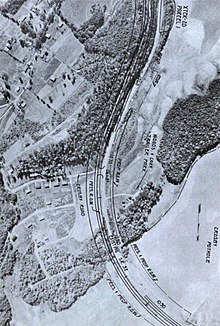This article needs additional citations for verification. (September 2021) |


The type of right of way (also right-of-way) considered here, is an easement, granted, purchased, or reserved over land for transportation purposes. This differs from a right of way established by prescription, where the legal right has been established by use in continuous and open manner for a statutorily prescribed number of years.[1] Included are highways, railways, canals, as well as for infrastructure equipment such electrical transmission, oil, and gas pipe lines, tthat enable access to another property or properties. Footpaths and trails established by governments, private individuals or organizations, not established already by prescription, are included.[2] In some cases an easement, can revert to its original owners if the facility is abandoned. A right of way for access may be restricted to a single grantee.
The term "right of way" is also used to denote the land itself, such as the strips of land along a railroad track on which railroad companies own a right of way easement, or a trail or path.
- ^ Easements by prescription, also called prescriptive easements, are implied easements granted after the dominant estate has used the property in a hostile, continuous and open manner for a statutorily prescribed number of years. Prescriptive easements differ from adverse possession by not requiring exclusivity]. "Adverse possession", Cornell University Law School
- ^ Henry Campbell Black: Right-of-way. In: A law dictionary containing definitions of the terms and phrases of American and English jurisprudence, ancient and modern: and including the principal terms of international, constitutional, ecclesiastical, and commercial law, and medical jurisprudence, with a collection of legal maxims ... (West Publishing Co., 1910), pg. 1040.
© MMXXIII Rich X Search. We shall prevail. All rights reserved. Rich X Search
